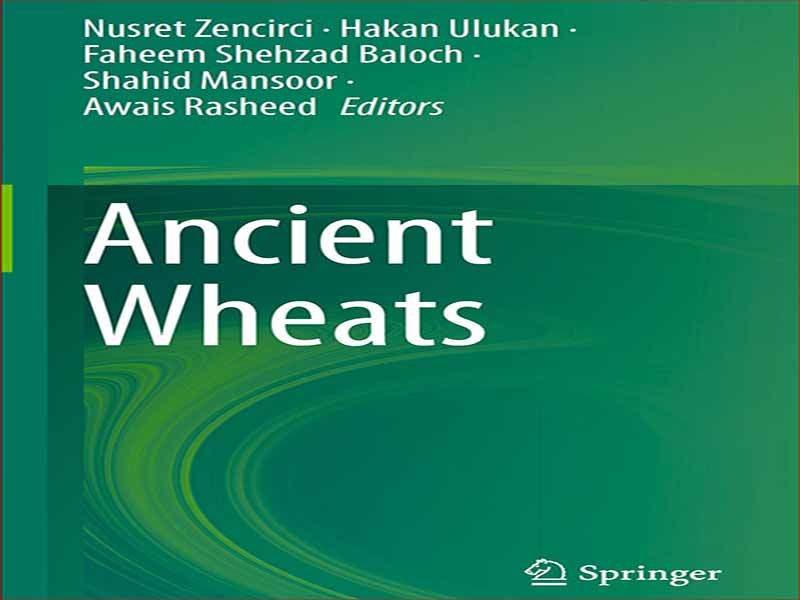- عنوان کتاب: Ancient Wheats
- نویسنده: Nusret-Zencirci,-Hakan-Ulukan
- حوزه: غلات
- سال انتشار: 2022
- تعداد صفحه: 267
- زبان اصلی: انگلیسی
- نوع فایل: pdf
- حجم فایل: 13.2 مگابایت
نقش فزاینده اقوام وحشی گندم و گونه های کم استفاده برای امنیت غذایی، پایداری و بهبود محصول به رسمیت شناخته شده است. خویشاوندان وحشی و اهلی گندم از جنس های Aegilops و Triticum می توانند منابع ارزشمند تنوع ژنتیکی برای بهبود محصول باشند. با این حال، به دلیل محدودیتهایی که در مطالعه این خویشاوندان وحشی وجود دارد، بیشتر تحقیقات بر روی اشکال کشت شده یا نژادهای بومی متمرکز شده است. در این میان، گندمهای باستانی (Einkorn، Emmer، spelt، macha و vavilovii)، هم به صورت وحشی و هم به صورت کشت شده، در سالهای اخیر مورد توجه گستردهای قرار گرفتهاند. گندم های باستانی با “دانه غیرقابل کوبیدن از پوسته” در طی فرآیندهای سنتی خرمنکوبی مشخص می شوند. گندم های باستانی از جنوب شرقی ترکیه سرچشمه می گیرند، اما امروزه معمولاً در آنجا کشت نمی شوند. آنها در مناطق کوچک و مرتفع تر در سراسر ترکیه مانند Kastamonu، Samsun، Kars، Sinop، Bolu، Bayburt، Gümüşhane و Kayseri وجود دارند. به طور کلی، این مکان ها شرایط محیطی سخت تری دارند که ممکن است دلیلی بر ترجیح کشاورزان با این گونه ها باشد.
اگرچه در هر سطح پلوئیدی Triticum گونههای متعددی وجود دارد (دیپلوید، تتراپلوئید و هگزاپلوید)، گندمهای باستانی که به طور گسترده رشد میکنند، Triticum monococcum ssp است. monococcum L.، گندم einkorn (Siyez یا IZA در ترکی). این گونه امروزه به عنوان غذای حیوانات و در برخی نقاط به عنوان غذای انسان پرورش داده می شود. قدمت کشت گندم باستانی به 12 تا 14000 سال می رسد، و گسترش گندم های آزاد خرمن و پرمحصول این گونه را به زمین های کوچک و عمدتاً حاشیه ای با خاک های ضعیف یا ارتفاعات بالاتر سوق داد. گندم های باستانی امروزه در ترکیه، آلبانی، اتریش، اسپانیا و آلمان کشت می شوند. علاوه بر گندم einkorn، emmer (T. dicoccum Schrank) و گندم املایی (T. spelta L.) دیگر اشکال قابل توجه گونه های گندم باستانی هستند. از گونه های گندم باستانی کمتر شناخته شده می توان به T. macha Dekarp اشاره کرد. & Menabde، و T. vavilovii Thum. تلاش ها برای اصلاح گندم از زمان های قدیم بیشتر بر عملکرد دانه متمرکز بوده است. مهمترین جزء عملکرد محتوای نشاسته بود. از آنجایی که نشاسته بیشتر در بافت آندوسپرم ذخیره می شود، آندوسپرم بزرگتر ترجیح کشاورز و مصرف کننده بوده است. با عملکرد دانه به عنوان مهمترین صفت مورد علاقه، گلوتن، پروتئین، محتویات نشاسته و تحمل/مقاومت به تنش زیستی و غیرزیستی اهداف اضافی در اکثر برنامه های اصلاحی بوده است.
The increased role of wheat’s wild relatives and underutilized species for food security, sustainability, and crop improvement has been recognized. Wild and domesticated relatives of wheat from the genera Aegilops and Triticum can be invaluable resources of genetic diversity for crop improvement. However, because of the limitations with studying these wild relatives, most investigations have concentrated on cultivated forms or landraces. Among these, the ancient wheats (einkorn, emmer, spelt, macha, and vavilovii), both in wild and cultivated forms, have received expanding interest in recent years. Ancient wheats are characterized by “non-threshable grain from the hull” during the traditional threshing processes. Ancient wheats originated from Southeastern Turkey, however, are not commonly grown there today. They exist in small, higher elevation regions throughout Turkey, such as Kastamonu, Samsun, Kars, Sinop, Bolu, Bayburt, Gümüşhane, and Kayseri. Generally, these locations have harsher environmental conditions, which may be a reason for farmer preference with these species.
Even though there are multiple species within each ploidy level of Triticum (diploid, tetraploid and hexaploid), the most widely grown ancient wheat is Triticum monococcum ssp. monococcum L., einkorn wheat (Siyez or IZA in Turkish). This species is grown today as animal feed, and as human food in some places. Cultivation of ancient wheat dates to 12–14,000 years, and expansion of free-threshing, high- yielding wheat pushed this species to small, mostly marginal lands with poor soils or higher elevations. Ancient wheats are grown today in Turkey, Albania, Austria, Spain, and Germany. In addition to einkorn wheat, emmer (T. dicoccum Schrank) and spelt wheat (T. spelta L.) are other noteworthy forms of ancient wheat species. Lesser-known ancient wheat species include T. macha Dekarp. & Menabde, and T. vavilovii Thum. Efforts on wheat breeding since ancient times are mostly concentrated on grain yield. The most important yield component was starch content. Since starch is mostly stored in endosperm tissue, larger endosperm has been a preference by farmer and consumer. With grain yield as the most important trait of interest, gluten, protein, starch contents, and biotic and abiotic stress tolerance/resistance have been additional aims in most breeding programs.
این کتاب را میتوانید از لینک زیر بصورت رایگان دانلود کنید:
Download: Ancient Wheats




































نظرات کاربران